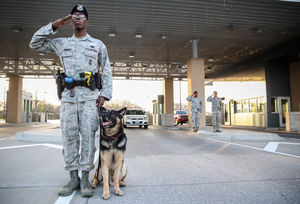Grace: Military recruit dog Rocky flunked his tests — twice — but Offutt teacher gave him a 2nd chance
By Erin Grace, World-Herald columnist | Updated 6 days ago

Staff Sgt. Elbert Lee Foreman Jr., with a blue Kong dog toy on his belt, with Rocky, a 5-year old German shepherd, at Offutt Air Force Base. Rocky is an explosive-detector and patrol dog on base. “He’s an awesome dog,” Foreman said. “A really good dog.” Photo by Megan Smith, The World-Herald
A young U.S. military recruit named Rocky showed promise at the start. But when he started training at a Texas base and flunked his tests — twice — Rocky’s would-be military career seemed all but over.
Then a teacher at Offutt Air Force Base saw potential. And the German shepherd came to Bellevue for a second chance.
This four-legged student remains a work in progress, but he is an official military working dog. And his story shows that, like the two-legged kind, students of all species can benefit from the right teacher and the right kind of setting.
In Rocky’s case, the right teacher was a dog-loving, dog-knowing human, Master Sgt. Michael Iverson. Iverson’s a believer in so-called lost causes. He’s a teacher who thinks that if the student flunks, maybe it’s the teacher’s fault.
Rocky’s story began in 2010 in the Netherlands, where he was born to a breeder who works with the U.S. Department of Defense.
The world’s most powerful military has a lot of space-age tools like drones at its disposal. But when it comes to sniffing out an explosive chemical or helping a guard patrol the base, just about nothing beats a trained dog.
The Air Force supplies all the service branches with trained dogs — usually German shepherds or, increasingly, Belgian Malinois.
For reasons obvious to anyone who has ever owned a puppy, the Air Force does not typically start with a cute, cuddly, chewing, peeing, Tasmanian devil. Instead, the Air Force waits to bring the dog home until breeders have done the dirty work of civilizing dogs. So by the time the Air Force paid about $2,000 for Rocky at the end of 2011, Rocky could sit, he could heel, he could follow basic dog commands.
Rocky passed initial tests. Then, like human recruits, he had to go through boot camp — at the 37th Training Wing of Lackland Air Force Base, part of Joint Base San Antonio in Texas.
In 2012, Rocky had his first big test of his training. But he failed.
More precisely, according to his training record, Rocky “was inconsistent in basic obedience and controlled aggression tactics.”
In other words, Rocky was a softie. Military working dogs have to be able to bite someone. Rocky couldn’t — or wouldn’t — cross that line at Lackland.
His trainers there kept working with him. He passed training to detect explosives, but failed patrol work. He was even given an extra 38 days of training, which helped. Rocky became a better listener. He didn’t go berserk when a gun was fired at close range. Yet Rocky still couldn’t attack.
His final report card at Lackland sounded a bit hopeless.
“Rocky shows insufficient drive and power,” reads that September 2013 report.
Rocky was going to be limited to explosive detection work — or sent away for adoption. Dogs that retire or wash out of the military are available for adoption as pets.
That’s when Iverson stepped in.
Iverson has spent most of his 16 years of Air Force duty dealing with dogs. He is kennel master for the 55th Security Forces Squadron, based at Offutt, which normally has eight dogs. Before that role, Iverson had been a trainer at Lackland. And before that, he was a South Dakota kid who
spent time on ranches with plenty of working dogs.
Iverson knew dogs. He owned dogs. He loved dogs. And he believed in the training potential of dogs and in his abilities as a trainer.
Iverson had needed another dog for the 55th. So he called Lackland to get his name on a waiting list for a fully-trained dog. He could wait for one, Lackland told him. Or he could try his luck with a borderline student named Rocky.
“We needed a dog,” Iverson said. “I like the challenge.”
As it turned out, Iverson was heading to San Antonio anyway that fall for the dedication of a new war dog memorial. While there, he looked at Rocky’s records, which, depending on your perspective, were either half-terrible or half-good. Iverson met Rocky and saw “above-average” behavior. He was sold.
Iverson had driven to Texas in his Ford pickup by himself. He drove home with Rocky.
In Rocky, Iverson saw smarts, ability — and utter confusion. In those early days, Rocky seemed unsure, nervous and afraid of making a mistake.
Who could blame him? At times, he is asked to follow commands related to his specific training, like detecting a hazardous substance. But he is also expected to rely on animal instinct if a threat is imminent. In those scenarios, he needs to act and act fast.
Iverson realized that he had to bond with Rocky and build his confidence. So he spent the initial weeks hanging out in Rocky’s kennel, walking Rocky all around the base and playing lots of fetch.
When Iverson realized how much Rocky loved an oblong rubber toy called a Kong, Iverson made it a reward. Sit? Kong. Down? Kong. Find the requisite hazardous substance? Kong. Iverson accompanied the toy with a hearty “Yes!” each time Rocky did something right.
As the dog’s bond and confidence grew, Iverson was able to work on aggression. A fellow trainer was designated the “bad guy” and was able to goad Rocky into protection mode. Iverson then taught Rocky how to trust his defensive instinct.
How well did he do?
Iverson took us outside. When Rocky heard the crack of a whip or was approached by an airman wearing a protective coat, he bared his teeth and reared up, clamping onto the airman’s arm with his steel-trap jaw. He did not show fear. He did show a willingness to bite.
Rocky is not officially certified in this area yet — but he’s close.
Iverson believes Rocky’s prior training involved too many people and too much change. Maybe he was confused. Maybe Rocky just needed a change of environment. Or maybe he just needed someone to believe in him.
But dealing with change is an important skill, especially for a military working dog, and Iverson has had to prepare Rocky for the array of handlers he’ll have over his career. So far, he is on his third handler, Staff Sgt. Elbert Lee Foreman Jr.ky’s prior training involved too many people and too much change. Maybe he was confused. Maybe Rocky just needed a change of environment. Or maybe he just needed someone to believe in him.
The 24-year-old from North Carolina has two dogs at home and got into the Air Force specifically to work with dogs.
Now the two are together during Foreman’s 12-hour shifts, which require patrolling part of the base’s 4,000 acres, responding to on-base police calls and conducting random vehicle searches.
During a recent shift, Foreman led Rocky through vehicle searches and a walk through the base exchange.
They took a quick break and the pair mirrored the usual, shamelessly gushy relationship between man and dog.
Foreman grinned at Rocky and took out a prize — the Kong.
“Down,” Foreman said, and Rocky obliged, earning praise, plus the toy.
Foreman bent down, rubbed Rocky’s face and said: “Yes, oooh-hoo-hoo. Good boy!”
“He’s an awesome dog,” said Foreman. “A really good dog.”
Nearby, Iverson watched them with a big grin. He felt like a proud teacher, watching an A student.



